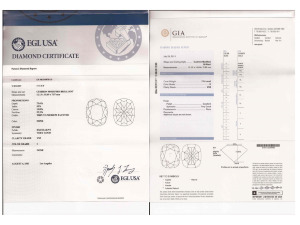CharmyPoo
Ideal_Rock
- Joined
- Dec 10, 2004
- Messages
- 7,007
Dreamer_D said:Rock diamond I would love to know more about how Fluor can make color grading hard. How do different colora of Fluor affect color grading?


CharmyPoo|1407541138|3728861 said:Since it doesn't seem like many consumers want to play, I will reveal the results and very interested to see what David thinks.
The larger loose diamond is graded as a Transitional Round Brilliant and as a GIA (NYC branch) M and an EGL (Toronto branch) L. This is consistent with what I see from these two GIA labs. The GIA NYC lab is consistently one grade lower than EGL Toronto lab in color. Both labs graded no fluorescence and VVS2.
In my own comparisons of the set stone, it is far whiter than the loose stone from a top down, bottom up and side perspective with indoor non-uv lighting. I compared it to a GIA K / EGL J stone and it still appeared whiter but more yellow than GIA G and GIA H stones. In outdoor sunlight, the set stone will turn close to shade of the GIA K / EGL J stone.
I took the stone into EGL (Toronto Branch) to get it graded - they discovered that the diamond was inscribed with a GIA number. GIA graded the stone as O-P with medium yellow fluorescence. EGL then took the GIA specs and graded it exactly the same - O-P with medium yellow fluorescence.
Now, I for the life of me cannot see ANY WAY possible that this stone (without applying UV light) can be seen as more yellow than the wide range of stones I compared it to. This leads me to wonder if GIA uses UV lighting when grading color even though I think color should be the grade without the influence of fluorescence. I am also surprised that EGL would match the GIA specs but perhaps this is them being consistent.
On a side note, I have never seen yellow fluorescence in a white diamond ... so that was interesting.
Oldminer|1407679650|3729653 said:One can spend hours on lab results which differ from one another. Reliable grading which inherently fits in with current market pricing is GIA based n the USA. Labs which happen to also grade accurately exist, but play less of a role in the market and prices tend to be discounted. Labs which are notorious for bad grading trade at far larger discounts within the trade. At the consumer level, there is no fixed situation. The price paid is dependent upon the sophistication of the consumer and can greatly vary in differing situations
It is possible to have UV free lighting and easily done, however, such a regimen does not assure no fluorescence. It does assure no UV fluorescence. Diamonds can fluoresce from wavelengths of light other than UV which are in the visible spectrum, too. Lots of lighting being sold as UV lighting is in the lower end of the visible spectrum and not UV but still some diamonds may react quite strongly to these visible light wavelengths. The impossible trick would be to grade a diamond without any chance of any fluorescence occurring whether it is from UV light or some wavelength of visible light. Fluorescence can be as little as a subtle color shift up to a very strong glow. Even a rather weak amount may have an adverse effect on consistent color grading of diamonds because the trade does not really have a "standard" lighting product which is "required' to be in use for every diamond grading house or lab. It could be a very simple LED lighting tool, not thousands of dollars, but there is nothing forcing this on the industry and the GIA is best served by being on top of the mountain looking down on the rest rather than putting us all on a somewhat more even footing. If all labs were the same, there would be no lab on top any more.
